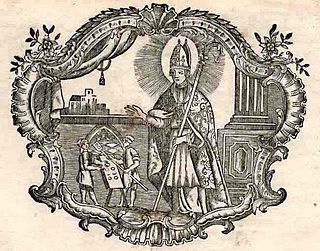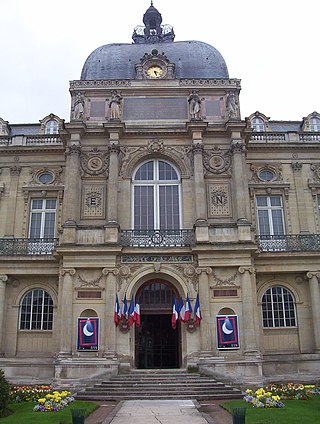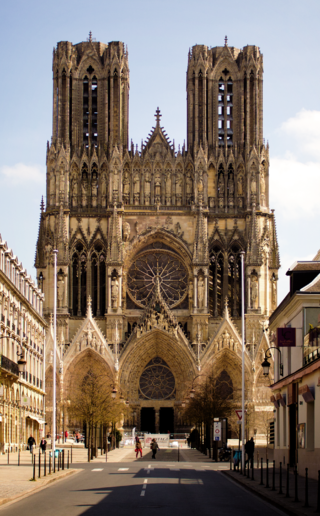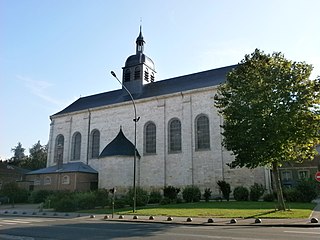
Gothic architecture is an architectural style that was prevalent in Europe from the late 12th to the 16th century, during the High and Late Middle Ages, surviving into the 17th and 18th centuries in some areas. It evolved from Romanesque architecture and was succeeded by Renaissance architecture. It originated in the Île-de-France and Picardy regions of northern France. The style at the time was sometimes known as opus Francigenum ; the term Gothic was first applied contemptuously during the later Renaissance, by those ambitious to revive the architecture of classical antiquity.

Amiens is a city and commune in northern France, located 120 km (75 mi) north of Paris and 100 km (62 mi) south-west of Lille. It is the capital of the Somme department in the region of Hauts-de-France and had a population of 135,429, as of 2021. A central landmark of the city is Amiens Cathedral, the largest Gothic cathedral in France. Amiens also has one of the largest university hospitals in France, with a capacity of 1,200 beds. The author Jules Verne lived in Amiens from 1871 until his death in 1905, and served on the city council for 15 years. Incumbent French president Emmanuel Macron was born in Amiens.

Picardy is a historical territory and a former administrative region of France. Since 1 January 2016, it has been part of the new region of Hauts-de-France. It is located in the northern part of France.

Fermin was a legendary holy man and martyr, traditionally venerated as the co-patron saint of Navarre, Spain. His death may be associated with either the Decian persecution (250) or Diocletianic Persecution (303).

The Cathedral Basilica of Our Lady of Amiens, or simply Amiens Cathedral, is a Roman Catholic church. The cathedral is the seat of the Bishop of Amiens. It is situated on a slight ridge overlooking the River Somme in Amiens, the administrative capital of the Picardy region of France, some 120 kilometres north of Paris.

The Cathedral of Saint Peter of Beauvais is a Roman Catholic church in the northern town of Beauvais, Oise, France. It is the seat of the Bishop of Beauvais, Noyon and Senlis.

French art consists of the visual and plastic arts originating from the geographical area of France. Modern France was the main centre for the European art of the Upper Paleolithic, then left many megalithic monuments, and in the Iron Age many of the most impressive finds of early Celtic art. The Gallo-Roman period left a distinctive provincial style of sculpture, and the region around the modern Franco-German border led the empire in the mass production of finely decorated Ancient Roman pottery, which was exported to Italy and elsewhere on a large scale. With Merovingian art the story of French styles as a distinct and influential element in the wider development of the art of Christian Europe begins.
In French Gothic architecture, the Rayonnant style is the third of the four phases of Gothic architecture in France, as defined by French scholars. Related to the English division of Continental Gothic into three phases, it is the second and larger part of High Gothic.

Rouen Cathedral is a Catholic church in Rouen, Normandy, France. It is the see of the Archbishop of Rouen, Primate of Normandy. It is famous for its three towers, each in a different style. The cathedral, built and rebuilt over a period of more than eight hundred years, has features from Early Gothic to late Flamboyant and Renaissance architecture. It also has a place in art history as the subject of a series of impressionist paintings by Claude Monet.

Saint Honoratus of Amiens was the seventh bishop of Amiens. His feast day is May 16.
Ulphia of Amiens is a Christian saint, venerated particularly at Amiens. She was said to be a young girl living on the banks of the Noye in the who became a hermit at what would become Saint-Acheul, near Amiens in the Kingdom of the Franks, under the spiritual direction of Saint Domitius (Domice). At the end of her life, she formed and directed a community of religious women at Amiens. Her feast day is January 31.

The Diocese of Amiens is a Latin Church diocese of the Catholic Church in France. The diocese comprises the department of Somme, of which the city of Amiens is the capital.

French Gothic architecture is an architectural style which emerged in France in 1140, and was dominant until the mid-16th century. The most notable examples are the great Gothic cathedrals of France, including Notre-Dame Cathedral, Reims Cathedral, Chartres Cathedral, and Amiens Cathedral. Its main characteristics are verticality, or height, and the innovative use of the rib vault and flying buttresses and other architectural innovations to distribute the weight of the stone structures to supports on the outside, allowing unprecedented height and volume. The new techniques also permitted the addition of larger windows, including enormous stained glass windows, which fill the cathedrals with light.

Fouencamps is a commune in the Somme department in Hauts-de-France in northern France.
Saints Acheolus and Acius were early Christian martyrs in Gaul. They are associated with Amiens, where Acheolus's name was given to an ancient church, later an abbey.

The Musée de Picardie is the main museum of Amiens and Picardy, in France. It is located at 48, rue de la République, Amiens. Its collections include artifacts ranging from prehistory to the 19th century, and form one of the largest regional museums in France.

High Gothic followed Early Gothic architecture and was succeeded in France by Late Gothic in the form of the Flamboyant style. This timetable is not used by French scholars; they divide Gothic architecture into four phases, Primary Gothic, Classic Gothic, Rayonnant Gothic and Flamboyant Gothic. Therefore, in French terms, a few first examples of High Gothic are Classic, but most examples are Rayonnant. High Gothic is often described as the high point of the Gothic style.

The Abbey of Saint-Acheul was a monastery of Canons Regular in the Saint-Acheul district of Amiens, France. It was founded in the 11th century on the site of an ancient church, and was suppressed in 1790 during the French Revolution. The buildings, which date to the 18th century, were taken over by a college that was entrusted to the Jesuits in 1814. They are now occupied by the private Lycée Saint-Riquier. The abbey church is used as a parish church.

Gothic cathedrals and churches are religious buildings created in Europe between the mid-12th century and the beginning of the 16th century. The cathedrals are notable particularly for their great height and their extensive use of stained glass to fill the interiors with light. They were the tallest and largest buildings of their time and the most prominent examples of Gothic architecture. The appearance of the Gothic cathedral was not only a revolution in architecture; it also introduced new forms in decoration, sculpture, and art.

Saint Salvius of Amiens was a 7th-century bishop of Amiens. His feast day is 11 January.

















